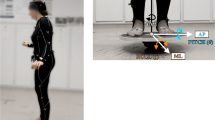Abstract
Despite evidence that long-term dance exercise results in improved functional balance in older adults, it remains unclear whether people must first achieve a minimum level of skill before they can benefit from the exercise in terms of body balance. In order to evaluate whether or not exercise during early learning of dance is beneficial, we asked dance-inexperienced older adults to perform in pairs a 30-min lesson of danzón. Motion capture and ground reaction force recordings were used to determine the variability of body sway during quiet, upright standing before and immediately after the lesson. Significant reductions in variability of sway normalized by body height were found following the dance exercise. Interestingly, the taller individual who was instructed to take the “leader” role showed greater gains. Our findings indicate that learning to dance danzón at a beginner’s level may be beneficial for balance in the elderly, despite the increased cognitive load in the early stages of skill acquisition.


Similar content being viewed by others
References
Buchner, D. M., Cress, M. E., de Lateur, B. J., Esselman, P. C., Margherita, A. J., Price, R., et al. (1997). A comparison of the effects of three types of endurance training on balance and other fall risk factors in older adults. Aging Clinical and Experimental Research, 9(1–2), 112–119.
Federici, A., Bellagamba, S., & Rocchi, M. B. L. (2005). Does dance-based training improve balance in adult and young old subjects? A pilot randomized controlled trial. Aging Clinical Experimental Research, 17(5), 385–389.
Fitts, P. M., & Posner, M. I. (1967). Human performance. Belmont, CA: Brooks/Cole.
Flores y Escalante, J. (2006). Imágenes del Danzón, Iconografía del Danzón en México. [Danzón Images, Danzón Iconography in México]. México City: AMEF.
Howe, T. E., Rochester, L., Jackson, A., Banks, P. M. H., & Blair, V. A. (2007). Exercise for improving balance in older people. Cochrane Database Systematic Review, 4. CD004963. doi:10.1002/14651858.CD004963.pub2.
Johannsen, L., Guzmán-García, A., & Wing, A. M. (2009). Interpersonal light touch assists balance in the elderly. Journal of Motor Behaviour, 41(5), 397–399.
Judge, J. O. (2003). Balance training to maintain mobility and prevent disability. American Journal of Preventive Medicine, 25(3), 150–156.
Keogh, J. W. L., Kilding, A., Pidgeon, P., Ashley, L., & Gillis, D. (2009). Physical benefits of dancing for healthy older adults: A review. Journal of Aging and Physical Activity, 17(4), 479–500.
Lord, S., Matters, B., St. George, R., Thomas, M., Bindon, J., KamYin Chan, D., et al. (2006). The effects of water exercise on physical functioning in older people. Australasian Journal of Ageing, 25(1), 36–41.
McKinley, P., Jacobson, A., Leroux, A., Bednarczyk, V., Rossignol, M., & Fung, J. (2008). Community-based Argentine tango dance program improves functional balance and confidence in older people. Journal of Aging and Physical Activity, 16(4), 435–453.
Shigematsu, R., Chang, M., Yabushita, N., Sakai, T., Nakagaichi, M., Nho, H., & Tanaka, K. (2002). Dance-based aerobic exercise may improve indices of falling risk in older women. Age and Ageing, 31(4), 261–266.
Sofianidis, G., Hatzitaki, V., Douka, S., & Grouios, G. (2009). Effect of a 10-week traditional dance program on static and dynamic balance control in elderly adults. Journal of Aging and Physical Activity, 17(2), 167–180.
Verghese, J. (2006). Cognitive and mobility profile of older social dancers. Journal of the American Geriatrics Society, 54(8), 1241–1244.
Winter, D. A. (2005). Biomechanics and motor control of human movement. Hoboken, NJ: John Wiley & Sons.
Wolfson, L. (1996). Balance and strength training in older adults: Intervention gains and Tai-Chi maintenance. Journal of American Geriatrics Society, 44, 498–506.
Zhang, J. G., Ishikawa-Takata, K., Yamazaki, H., Morita, T., & Ohta, T. (2006). The effects of Tai Chi Chuan on physiological function and fear of falling in the less robust elderly: An intervention study for preventing falls. Archives of Gerontology and Geriatrics, 42(2), 107–116.
Acknowledgement
We acknowledge the financial support of the Biotechnology and Biological Sciences Research Council (BBSRC; BBF0100871) awarded to Professor Alan Wing and the Mexican National Council for Science and Technology (CONACYT) awarded to Azucena Guzmán-García, PhD Candidate. Further information about danzón can be provided by the authors on request.
Author information
Authors and Affiliations
Corresponding author
Rights and permissions
About this article
Cite this article
Guzmán-García, A., Johannsen, L. & Wing, A.M. Dance Exercise for Older Adults: A Pilot Study Investigating Standing Balance Following a Single Lesson of Danzón. Am J Dance Ther 33, 148–156 (2011). https://doi.org/10.1007/s10465-011-9114-6
Published:
Issue Date:
DOI: https://doi.org/10.1007/s10465-011-9114-6



